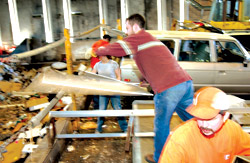Once again, residents of an aggrieved Seattle neighborhood are facing off against a city bureaucracy that they claim just doesn’t listen, and the Seattle City Council will have to decide who’s right.
The controversy, in this case, is over the proposed construction by Seattle Public Utilities (SPU) of a $70 million solid-waste transfer facility on a plot of industrially zoned land between Boeing Field and Interstate 5, part of a $160 million plan to overhaul Seattle’s waste facilities. The city’s waste would be transferred from trucks to a compactor and on to railcars for a trip to a landfill in Arlington, Ore. The north end of the targeted parcel of land is about six blocks south of the heart of historic Georgetown, and trucks serving the site would pass directly through that center. Business owners and the neighborhood’s 1,200 residents are up in arms.
Both sides have a point.
Residents are concerned about the truck traffic, to be sure, but the larger issue for many seems to be the question of why such an industrial facility is being sited so close to a residential neighborhood and why, once again, an undesirable public facility is being put in the not-so-affluent south end of the city.
Georgetown, in recent years, keeps threatening to become the next “chic” Seattle neighborhood. It’s historic, working class, racially diverse, and has some of the most (relatively) affordable homes in Seattle. There’s a thriving art and music scene. Several nightclubs have set up shop, and artists use warehouses in the area. Among the folks who would be displaced by the transfer facility is Pearl Jam. They have a practice facility there.
But the neighborhood’s growth has been hampered by relatively limited housing stock, which is surrounded by industrially zoned land. And after spending four years studying what began as more than 1,000 potential sites for the transfer facility, all four of the city’s finalist sites turned out to be on industrial land in South Seattle: the Georgetown site; a site midway between Georgetown and South Spokane Street, on South Edmunds Street; and two locations on Harbor Island. The Edmunds site was determined to be too small. The value of cargo being shipped through the Port of Seattle has skyrocketed in the past two years, so both the Port of Seattle and the Union Pacific and BNSF railroads balked at giving up shipped cargo for less profitable shipped waste. The Port announced it would refuse to sell either parcel of Harbor Island land to Seattle Public Utilities.
That left Georgetown.
It’s certainly true that a rash of less-than-desirable public facilities have been put south of the Ship Canal lately. But Seattle Public Utilities didn’t have much choice. For one, the waste itself is headed south of town; it would be, um, wasteful to move the city’s waste north in trucks so it could be shipped south. Also, the Seattle Public Utilities truck fleet is stationed in South Seattle. But most importantly, any siting in Interbay or other points north with rail access would send the railcars full of waste through downtown Seattle’s underground rail tunnels, a chronic transportation bottleneck. The rail companies that own the tracks refused to add to that bottleneck for less profitable waste shipments.
Georgetown residents have also raised the question of whether a new transfer station is needed at all, especially given the city’s long-term commitment to recycling and waste reduction. But on this point Seattle Public Utilities is firm. The current waste facilities, in Wallingford and south of the Duwamish, were built in the 1960s and are running out of room. The city’s waste stream hasn’t increased, but rather than one big lump of garbage, waste facilities must now make room for 10 different kinds of waste. There are new environmental regulations for handling recycled material, motor oil, old refrigerators, you name it. Even with remodels of the north and south public waste facilities (the other components of the $160,000 plan), SPU claims, there’s simply no room for garbage trucks and industrial waste at those sites. Utility officials insist that Georgetown truck traffic will be lower than with the current uses by businesses to be displaced and that most of SPU’s access for incoming trucks will be via I-5, bypassing Georgetown entirely.
None of this has mollified Georgetown residents, already aggrieved by previous government proposals—most recently, the scuttled Southwest Airlines bid to use Boeing Field. They tend to use emotionally loaded (and inaccurate) words like “dump” in describing the proposed facility. Their opposition raises uncomfortable questions of NIMBYism; after all, a garbage facility has to go somewhere, and whichever neighborhood lands it will object.
But it’s not NIMBYist to observe that the Georgetown site is the only one of the city’s four finalists to be near a residential neighborhood and that the city’s South End is, in fact, often a dumping ground for projects that don’t fit other locations. Such larger policy priorities are City Council business, and by late August the waste transfer facility will land squarely in the City Council’s lap.
Well, it’s got to go somewhere.







